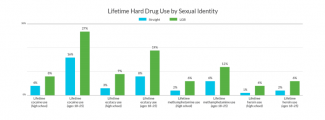
New Research on Sexual Identity and Substance Use
Addiction, mental health, trauma. They’re all connected. In order to find ways to prevent and treat one condition, we need to understand the broader picture—especially for those who face higher risks.
That’s why The Trevor Project, the world's largest suicide prevention and crisis intervention organization for LGBTQ young people, has conducted new research on substance use among lesbian, gay, and bisexual (LGB) young people.
Here’s what the research found.
LGB young people were more likely to report that they’d recently used alcohol or marijuana. For LGB high school students, their rate of use was 25% higher for alcohol and 62% higher for marijuana when compared to rates among their straight peers.
What’s more: LGB young people were two to three times more likely to use drugs like cocaine, heroin, and ecstasy.
Here’s what this means for LGB health.
There are three key elements to understand. First, we know that using substances at a young age is a risk factor for developing substance use disorders later in life. Second, we know that LGB young people use substances at higher rates than their straight peers, putting them at increased risk of future health harms. Third, we know that while substance use disorder is a devastating illness in itself, it’s also intricately linked to many other conditions: HIV, mental illness, and suicide risk, to name just a few.
Understanding how all of these circumstances impact people, as well as how they potentially compound each other, is very important in order to create a cohesive health care strategy that prevents tragic and unnecessary loss of life, especially for marginalized groups.
More research is needed to reflect the trans and nonbinary experience.
Amy E. Green, Ph.D., Director of Research for The Trevor Project, points out that “this data does not account for gender identity and we know that trans and nonbinary youth are at higher risk of suicidality. We must improve federal data collection around sexual orientation and gender identity to better understand substance use and suicidality among all LGBTQ youth.”
Remember this crucial detail: LGBTQ+ people aren’t at higher risk simply due to their sexual orientation or gender identity.
Being queer doesn't mean that you're inherently more likely to misuse substances or become addicted. Trauma and stress are what create risk. And unfortunately, LGBTQ+ people deal with these challenges in spades, simply by being who they are in a world that often does not accept or support them.
“One should not look at these disparities and jump to the conclusion that LGBTQ young people are prone to substance use because of their sexual orientation or gender identity. There are several underlying causes for LGBTQ young people’s higher rate of substance use, including increased risk for anxiety, depression, and suicidality,” Dr. Green notes. “Furthermore, these negative mental health outcomes often stem from increased experiences of discrimination, stigma, rejection from others, and victimization — including higher rates of sexual and physical abuse.”
Prevention efforts must be inclusive.
In terms of substance use disorders specifically, more research and funding are needed to understand how to most effectively prevent and treat them among LGBTQ+ youth. In the mean time, health care providers must be active allies for this population at every point of care.
In terms of LGBTQ+ health broadly, reducing stress, stigma, discrimination, and other trauma is critical. “The key to improving outcomes for LGBTQ young people is to reduce minority stress and increase support,” says Dr. Green. “This can be a combination of actions at the individual and societal levels, ranging from accepting and affirming the LGBTQ young people in your life to the enaction of policies that aim to protect youth like anti-bullying and anti-discrimination measures at school and in the workplace, and improve access to care from professionals who are competent in understanding the unique needs of LGBTQ young people.”





